Italian Beef Ragu
Italian Beef Ragu is the kind of dish that speaks the language of slow, soulful cooking. Built on humble ingredients—beef chuck, tomatoes, red wine, and herbs—this ragu simmers for hours until the meat is tender enough to fall apart with a fork, melting into a sauce that’s both rustic and rich with layered depth.
Anchored by pancetta, garlic, and parmesan rind, every element of the sauce adds warmth and comfort.
Whether spooned over ribbons of pappardelle, ladled onto creamy polenta, or served simply with crusty bread, this ragu is more than a meal—it’s a tradition, a mood, a memory in the making.
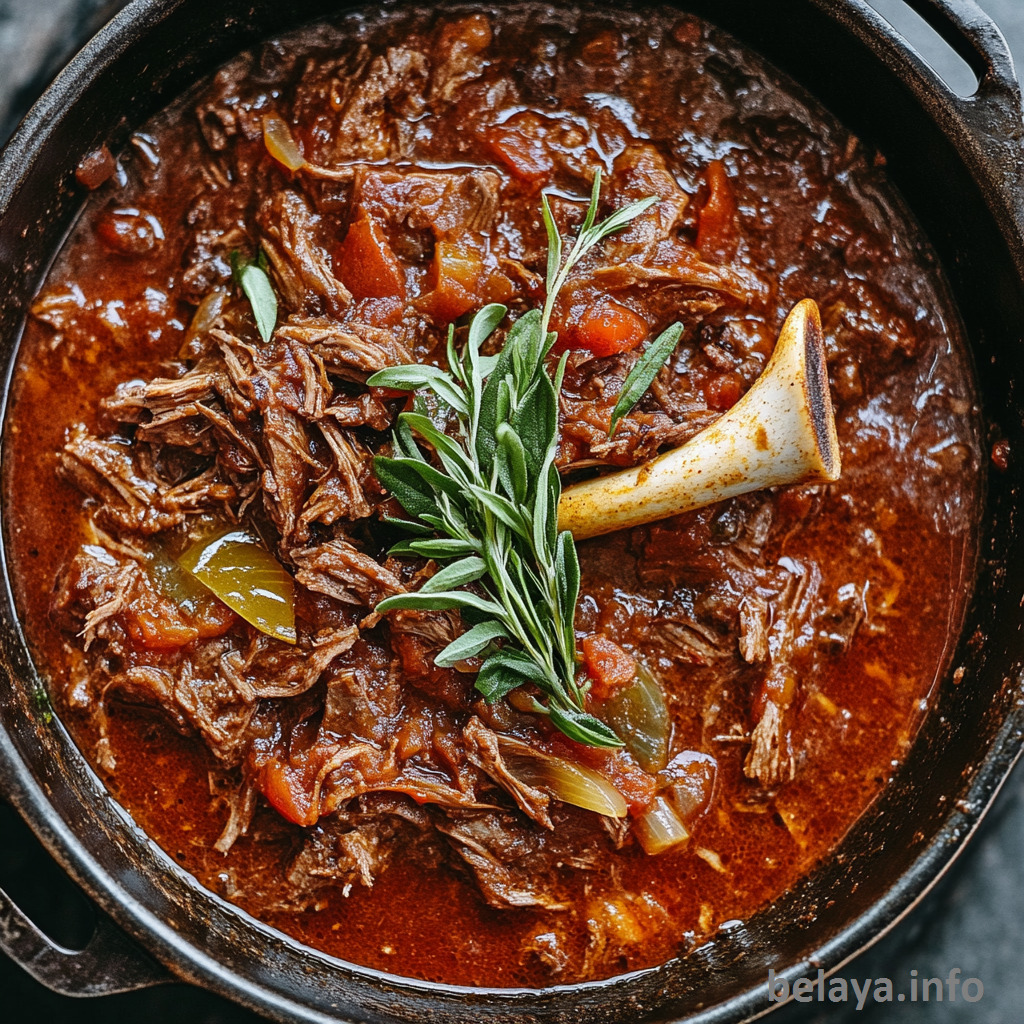
Why People Will Love This Italian Beef Ragu, presented in bullet format:
Slow-cooked flavor that feels like home: The long braise transforms simple ingredients into a deeply savory, fall-apart tender sauce—evoking comfort, patience, and tradition in every bite.
Rich layers of taste and texture: With pancetta, sun-dried tomatoes, herbs, red wine, and parmesan rind, the sauce develops complex depth—savory, slightly sweet, umami-rich, and perfectly balanced.
Unapologetically comforting: Whether served over wide pasta, creamy polenta, or even soft bread, this dish delivers soul-warming satisfaction that’s hearty but refined.
Perfect for gatherings and leftovers: It’s a make-ahead-friendly recipe that only gets better the next day—ideal for feeding a crowd or savoring slowly throughout the week.
A celebration of rustic Italian cooking: With its roots in regional tradition, this ragu connects eaters to the essence of Italian home kitchens—where time, flavor, and love are the key ingredients.

Key Ingredients:
Beef chuck: A well-marbled, slow-cooking cut that breaks down into succulent, shredded meat—providing both richness and body to the ragu. Its long braise infuses the sauce with deep, meaty complexity.
Pancetta: Adds a foundational layer of salt, fat, and umami. As it renders, it flavors the entire dish with subtle smokiness and a savory backbone.
Red wine: A classic Italian element that deglazes the pot and brings depth, acidity, and a touch of elegance—enhancing the beef while marrying all the flavors together.
Crushed tomatoes and tomato paste: These create the hearty base of the sauce, with tomato paste offering a concentrated sweetness and the crushed tomatoes providing texture and moisture.
Sun-dried tomatoes in oil: An often-overlooked secret weapon, they add a concentrated tangy-sweet intensity that elevates the sauce beyond a standard tomato ragu.
Fresh herbs (oregano, thyme, bay leaf): Tied into a bouquet garni, these herbs slowly release their aroma into the sauce, adding earthiness and herbal warmth that deepen as the dish simmers.
Parmesan rind: A traditional Italian technique that lends subtle nuttiness and umami to the sauce. It melts slowly, enriching the broth with savory depth.
Garlic and red pepper flakes: These aromatics infuse the sauce with heat, pungency, and warmth, giving the ragu a balanced kick without overpowering the core flavors.
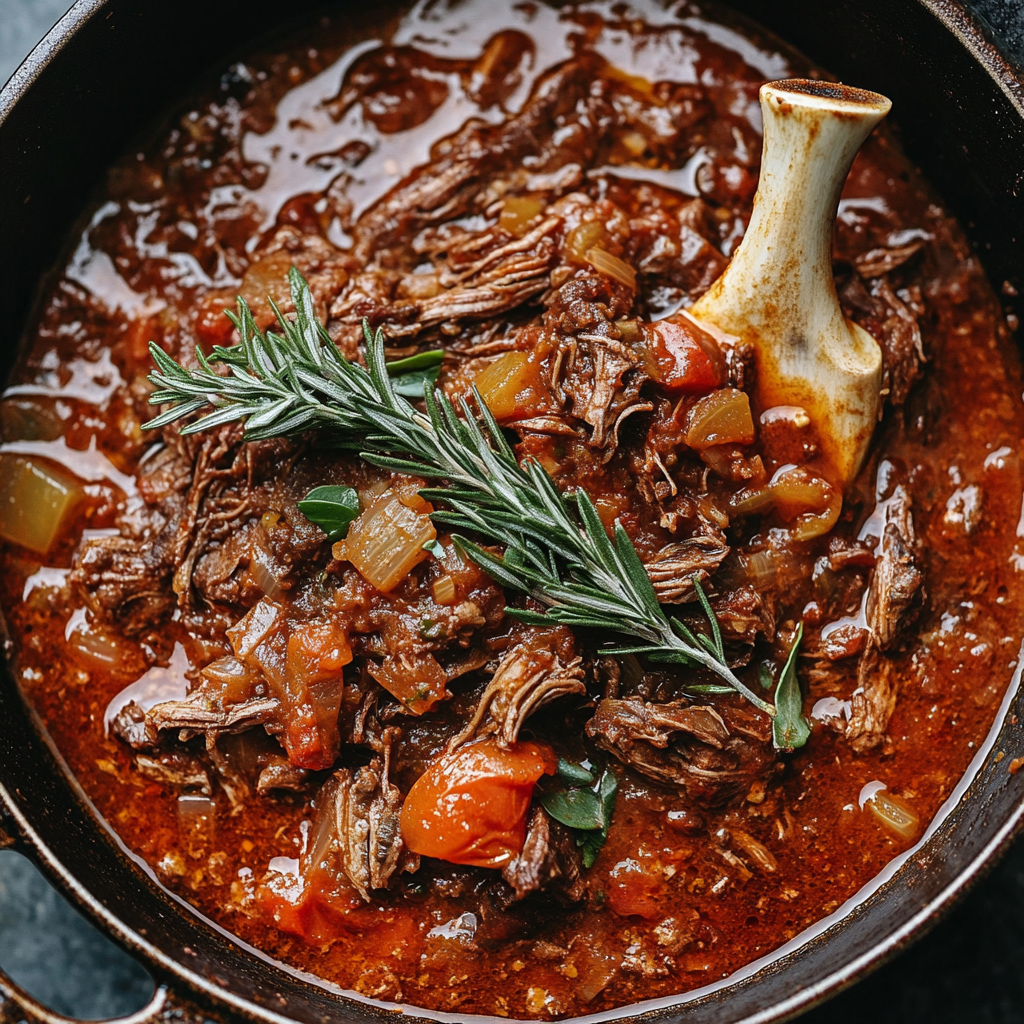
Expert Tips:
Sear the beef properly—don’t rush it: Take the time to deeply brown the beef cubes on all sides. This caramelization (Maillard reaction) develops a rich, meaty flavor base that carries through the entire dish. Avoid overcrowding the pot, or the beef will steam instead of sear.
Layer your flavors in stages: Build depth by adding ingredients gradually—pancetta first for fat and savoriness, followed by onion and garlic for aromatic sweetness, and tomato paste last to caramelize and intensify the sauce’s umami.
Use a bold red wine you’d actually drink: Choose a dry red wine like Chianti, Sangiovese, or Cabernet Sauvignon. A cheap or overly sweet wine will flatten the sauce’s complexity. Let it simmer before adding broth to burn off alcohol and concentrate its body.
Don’t skip the parmesan rind: This is a game-changer. It melts slowly into the sauce, lending an earthy, nutty savoriness that deepens the umami and helps thicken the texture.
Let the oven do the work—but finish on the stove: Oven-braising ensures even, gentle heat that breaks down collagen without scorching the sauce. But finishing the ragu uncovered on the stove gives you control over final texture and thickness.
Rest before shredding: Once the beef is tender, let it sit in the sauce for 10–15 minutes before shredding. This resting time allows the meat to reabsorb the juices, preventing dryness and keeping the final texture moist and luscious.
Add herbs and butter at the end for brightness and silkiness: Stir in chopped fresh herbs and cold butter right before serving. The herbs provide a vibrant lift to balance the richness, while the butter emulsifies the sauce for a velvety finish.
Serve with wide noodles or creamy polenta: Choose a pasta shape that can hold the heft of the sauce—pappardelle, tagliatelle, or rigatoni are ideal. Or go rustic with a ladle of ragu over creamy polenta for a true Italian comfort experience.
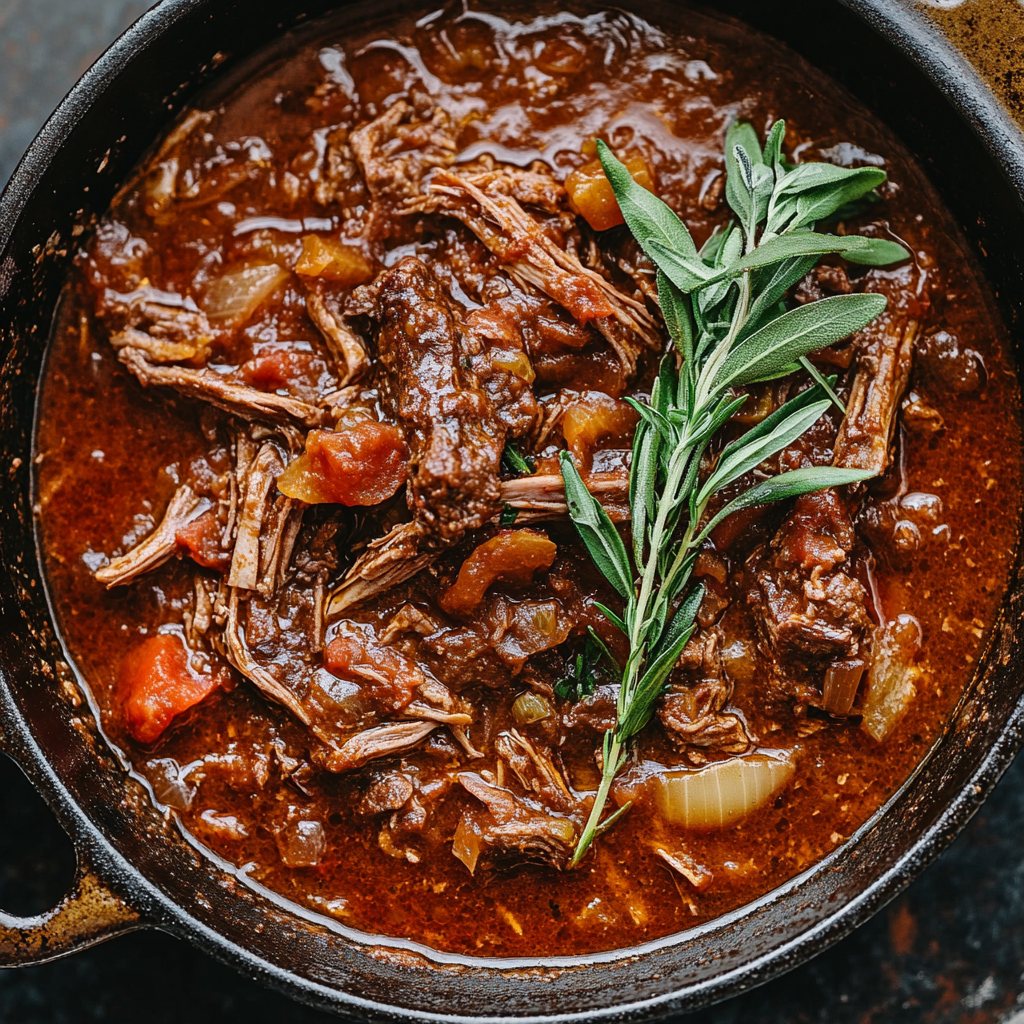
Italian Beef Ragu
Ingredients
1½ pounds beef chuck, cut into 2-inch cubes
2½ teaspoons kosher salt, divided
Freshly ground black pepper, to taste
1 tablespoon olive oil
4 ounces pancetta, finely diced
1 medium onion, diced
4 garlic cloves, thinly sliced
½ teaspoon red pepper flakes
1 tablespoon tomato paste
¼ cup sun-dried tomatoes in oil, finely chopped
1 (28-ounce) can crushed tomatoes
1 cup dry red wine
¾ cup beef broth or stock
3 sprigs fresh oregano, plus 1 tablespoon chopped leaves
3 sprigs fresh thyme, plus 1 teaspoon chopped leaves
1 fresh bay leaf
1 small piece of parmesan rind (about 1–2 inches)
2 tablespoons unsalted butter
½ cup freshly grated Parmesan cheese
Cooked pasta or rice, for serving
Instructions:
Preheat and season:
Preheat your oven to 300°F (150°C).
Generously season the beef cubes with 1½ teaspoons kosher salt and freshly cracked black pepper.
Brown the beef:
In a large Dutch oven, heat olive oil over medium heat until shimmering.
Sear the beef in 2–3 batches until deeply browned on all sides.
Transfer the seared beef to a bowl and set aside.
Sauté the base:
Reduce the heat to medium-low.
Add the diced pancetta and cook for about 5 minutes, until browned and the fat is rendered.
Stir in the onion, garlic, and red pepper flakes.
Sauté until softened, about 4–5 minutes.
Build the sauce:
Add the tomato paste and cook for 1–2 minutes, stirring constantly.
Then stir in the sun-dried tomatoes and crushed tomatoes.
Let the mixture simmer gently for 5 minutes.
Pour in the red wine and beef stock, and simmer for another 5 minutes.
Season with the remaining 1 teaspoon salt and more black pepper to taste.
Add herbs and braise:
Return the browned beef and any accumulated juices to the pot.
Tie the thyme, oregano, and bay leaf together to make a bouquet garni and add to the pot along with the parmesan rind.
Bring the mixture back to a simmer, then cover and transfer to the oven.
Cook for 3–4 hours, until the beef is fall-apart tender.
For a thicker sauce, uncover for the final 30 minutes.
Finish and serve:
Discard the bouquet garni and parmesan rind.
Remove the beef with a slotted spoon and shred it with two forks.
Return the shredded meat to the sauce.
Stir in the butter and chopped thyme and oregano.
Taste and adjust seasoning if needed.
Serve over pasta or rice, and finish with a generous sprinkle of grated parmesan.
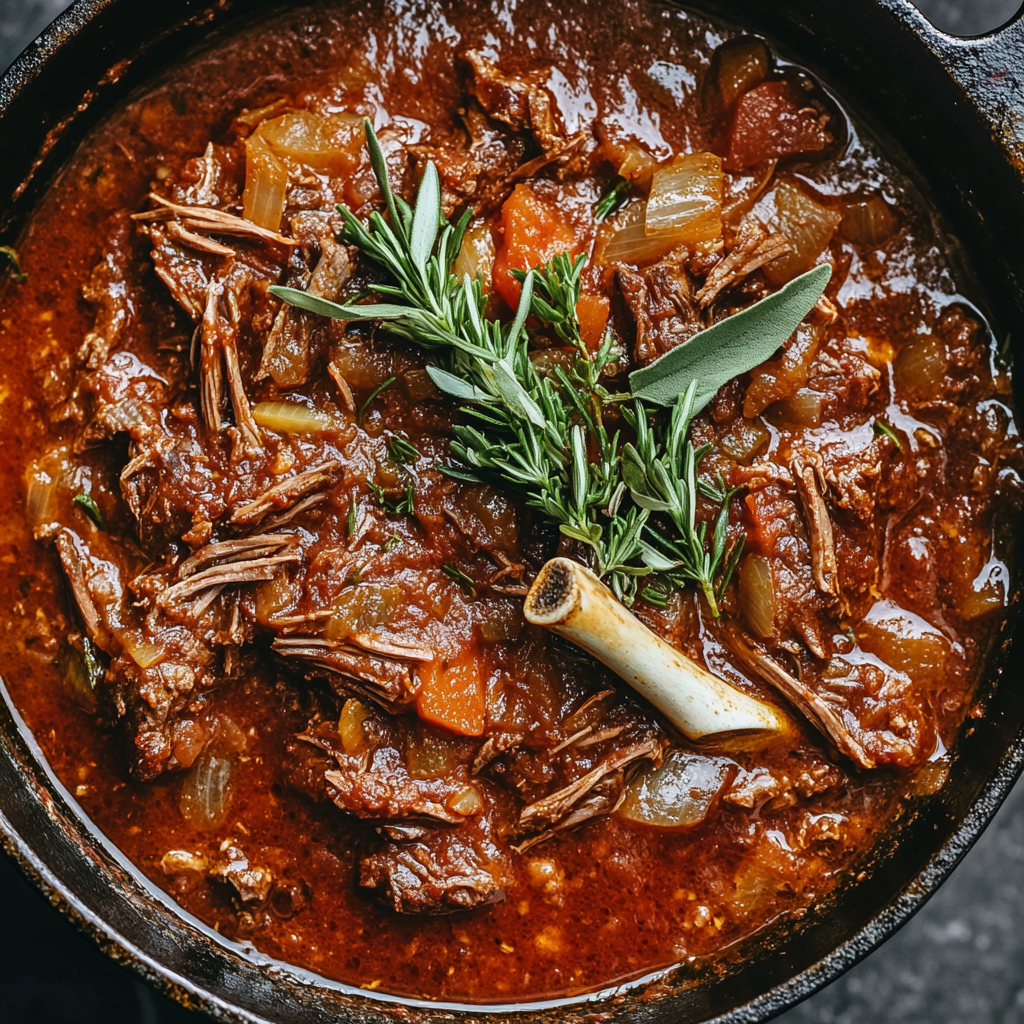
Important Notes When Making Italian Beef Ragu
Time is the key ingredient: This is not a quick sauce—it’s a slow-simmered labor of love. The 3–4 hour braise allows collagen in the beef to break down, yielding tender, shreddable meat and a rich, cohesive sauce that no shortcut can replicate.
Cut the beef into large chunks: Two-inch cubes might seem big, but they hold up beautifully through hours of cooking. Smaller pieces will break down too quickly and lose their texture, turning the sauce mealy rather than hearty.
The bouquet garni matters: Tying the thyme, oregano, and bay leaf into a bundle prevents stray herb stems in the final dish and allows for easy removal. These herbs slowly infuse the ragu with earthy, woodsy depth—subtle but essential.
Sun-dried tomatoes add hidden complexity: Though used in a small amount, their tangy sweetness balances the acidity of crushed tomatoes and the richness of the meat. Don’t skip them—they give the sauce an unexpected edge that sets it apart.
Use crushed tomatoes, not purée or whole: Crushed tomatoes provide the ideal texture—thick but not overly smooth. Purees can become pasty, while whole tomatoes vary too much in consistency.
Salt in stages, not all at once: Seasoning the beef before searing and again in the sauce ensures every component is well-flavored. Avoid adding all the salt at once—it’s easier to build flavor gradually than correct an over-salted dish.
Let the ragu rest before serving: After cooking and shredding the beef, let the sauce sit for 10–15 minutes with the meat stirred back in. This gives the flavors time to settle and the sauce to thicken naturally without needing flour or cornstarch.
Ragu always improves the next day: The sauce continues to develop complexity overnight. It’s one of those dishes that’s even better on day two—perfect for make-ahead meals or batch cooking.
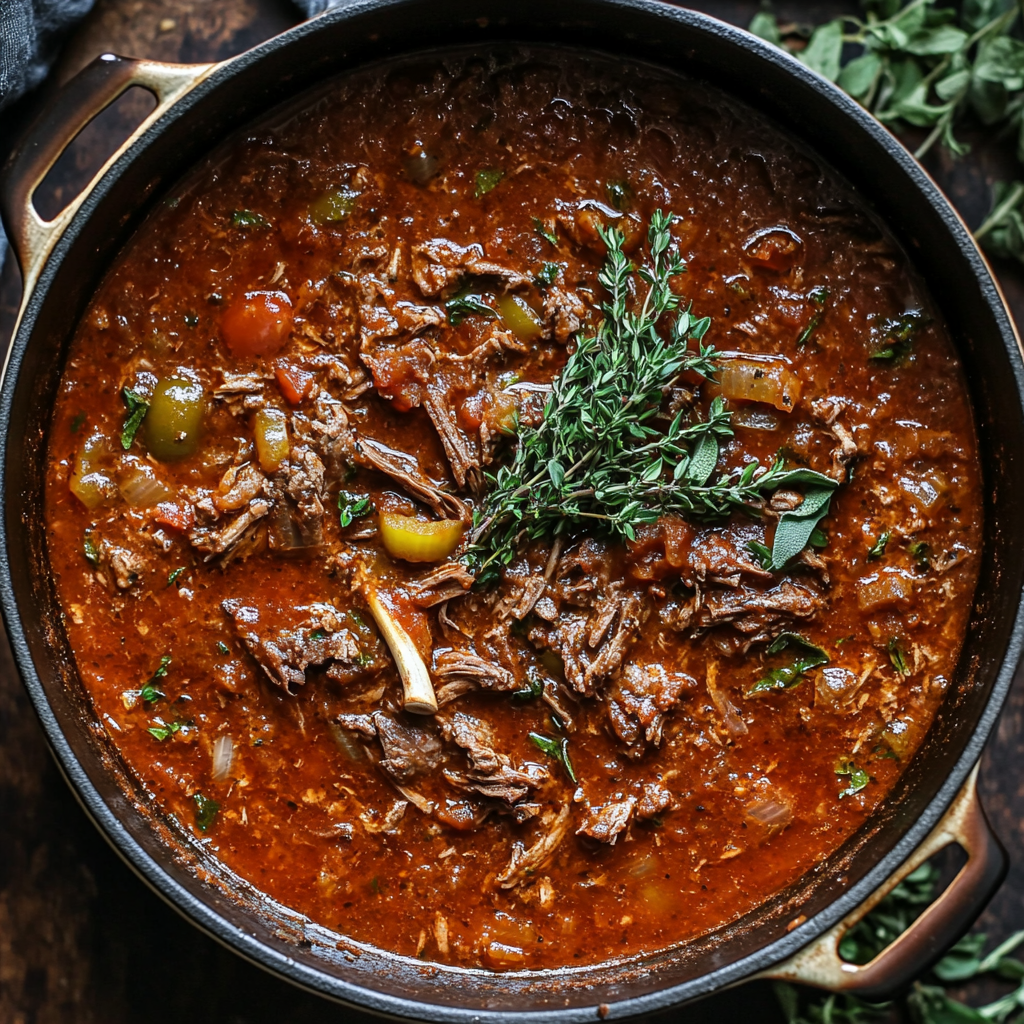
How to Enjoy Italian Beef Ragu After Cooking
Let It Rest Before Serving
Once the ragu has finished cooking and the beef is shredded back into the sauce, let it sit for 10–15 minutes off the heat. This rest allows the shredded meat to soak up the rich juices and ensures the flavors settle into a harmonious, silky consistency.
Pair with the Right Base
The base you serve your ragu with can transform the meal:
Pasta: Opt for pappardelle, tagliatelle, or rigatoni—shapes that hold up to the thick, meaty sauce. Cook the pasta al dente, toss it in the ragu, and add a splash of pasta water if needed to bind everything together.
Polenta: For a rustic and ultra-comforting option, ladle the ragu over a bed of creamy polenta. The cornmeal’s mild sweetness balances the robust sauce beautifully.
Mashed potatoes or crusty bread: Use as a cozy, unexpected base—or just tear off chunks of crusty sourdough and scoop directly from the plate.
Garnish Generously and With Intention
Right before serving, top your dish with freshly grated Parmesan or Pecorino Romano, a drizzle of extra virgin olive oil, or even a few fresh thyme leaves or chopped parsley for brightness. These final touches bring freshness, contrast, and visual appeal.
Serve with Complementary Sides and Sips
Balance the richness of the ragu with lighter or acidic sides:
Side salad: Arugula with lemon vinaigrette or a simple Italian chopped salad offers a refreshing contrast.
Wine pairing: Serve with a dry red wine like Chianti, Barbera, or Nero d’Avola—wines with acidity and body to stand up to the bold flavors of the ragu.
Roasted vegetables: Charred broccolini, roasted carrots, or sautéed greens provide earthiness and nutrition without competing for flavor.
Enjoy the Ritual of Leftovers
Italian Beef Ragu gets even better with time. The next day, use it creatively:
Layer it into a lasagna.
Turn it into a stuffed baked potato topping.
Spoon it over toasted sourdough for a ragu toast brunch.
Freeze in portions for instant weeknight dinners.
Savor It Slowly
This isn’t just a meal—it’s a slow-cooked celebration. Eat it slowly, with good company, a glass of wine, and no rush. The dish was built on time and care—it deserves to be enjoyed the same way.
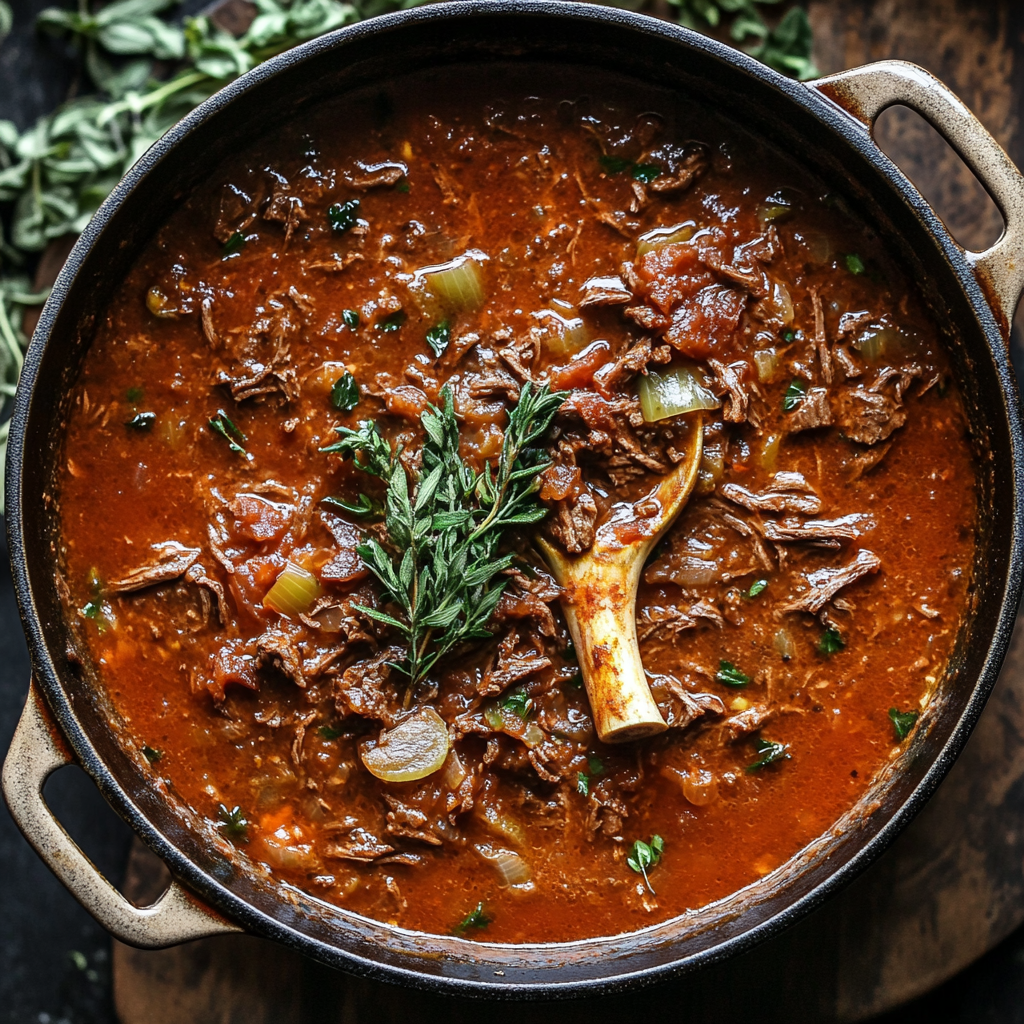
Nutrition Information
For one serving of Italian Beef Ragu (based on 6 servings, including meat, sauce, and parmesan but not pasta or rice), presented in your requested format:
Nutrition (Per Serving):
Calories: 415 kcal | Total Fat: 24.6 g | Saturated Fat: 9.8 g | Monounsaturated Fat: 10.4 g | Polyunsaturated Fat: 1.2 g | Cholesterol: 105 mg | Sodium: 680–750 mg (depending on added salt and parmesan) | Total Carbohydrates: 8.3 g | Dietary Fiber: 2.1 g | Sugars: 4.6 g | Protein: 35.2 g

Frequently Asked Questions:
Can I make this ragu ahead of time?
Absolutely. In fact, this ragu tastes even better the next day as the flavors deepen overnight. Store it in an airtight container in the fridge for up to 4 days, or freeze for up to 3 months. Reheat gently on the stovetop, adding a splash of stock or water if the sauce thickens too much.
What’s the best pasta to pair with this ragu?
Wide, flat noodles like pappardelle or tagliatelle are ideal—they cling beautifully to the rich, shredded meat sauce. For heartier meals, rigatoni or gnocchi also work well. If you prefer a rustic option, serve it over creamy polenta or mashed potatoes.
Can I use a different cut of beef?
Yes, beef chuck is ideal because of its marbling and connective tissue, but other braising cuts like brisket or short ribs also work well. Just make sure to cook low and slow until the meat is fall-apart tender.
Do I need to use wine, and can it be substituted?
Red wine adds depth and complexity, but if you prefer not to use alcohol, you can substitute with more beef stock plus a splash of balsamic vinegar or grape juice to mimic the acidity and roundness that wine provides.
What can I do if the sauce is too thin or watery?
If your ragu is thinner than you’d like, remove the lid for the last 30 minutes of cooking to allow the sauce to reduce. You can also simmer it uncovered on the stovetop for 10–15 minutes after shredding the beef to concentrate the flavor and thicken the consistency naturally.
How do I get a deep, flavorful sear on the beef?
Make sure the beef is dry before searing—pat it with paper towels to remove moisture. Use a hot Dutch oven and avoid overcrowding the pan. Brown in batches so each piece gets proper contact with the pan to develop that rich, caramelized crust that adds body to the sauce.
Why is pancetta added early in the cooking process?
Pancetta is rendered early to release its fat, which becomes the flavorful base for sautéing the onions, garlic, and pepper flakes. This step infuses the entire dish with a deep, savory richness that you can’t replicate later in the cooking process.
Can I skip the parmesan rind, and what does it do?
You can skip it, but it’s highly recommended. The rind slowly melts into the sauce, imparting subtle umami, saltiness, and a silky texture. If you don’t have a rind, add a small spoonful of grated parmesan during cooking and finish with extra at the end.
Why tie the herbs into a bouquet garni instead of chopping them all?
Tying whole sprigs of thyme, oregano, and a bay leaf together allows them to slowly infuse the sauce without leaving behind bits of woody stems. It also makes them easy to remove before serving, keeping the sauce smooth and refined.
What’s the best way to shred the beef without drying it out?
Let the beef rest in the sauce for 10–15 minutes after braising. Then use two forks to shred it directly into the pot or on a cutting board. This resting period allows the meat to reabsorb some of the juices, ensuring it stays moist and flavorful when mixed back into the sauce.